How many of our favorite holiday memories revolve around food? Spanning different cultures, regions and families, food is at the center of our tables and our traditions, especially during this time of year. So, inspired by the season, we set out to ask Food Bank staff, volunteers, and our community what some of their favorite holiday recipes and food-related memories are. Please enjoy this collection of stories and tasty treats – and let us know if you make any!
Hui Yu’s Soy Sauce Turkey and Potatoes
 We met Hui Yu at her neighborhood pantry in the SOMA district, where she volunteers regularly and picks up groceries for her and her husband as well. Prior to retirement, Hui Yu worked in a restaurant kitchen, so she’s no stranger to feeding others. Now, she often cooks meals for friends in her senior living facility who can’t make it out to the pantry. Poultry was at the top of Hui Yu’s list as a holiday main: “With chicken, sometimes I’ll roast or fry it. Or, we’ll have the whole family over and then celebrate together with a turkey. On the outside, I’ll use Chinese soy sauce, put it all over the skin, massage it, and then inside, put some potatoes.” Sounds delicious!
We met Hui Yu at her neighborhood pantry in the SOMA district, where she volunteers regularly and picks up groceries for her and her husband as well. Prior to retirement, Hui Yu worked in a restaurant kitchen, so she’s no stranger to feeding others. Now, she often cooks meals for friends in her senior living facility who can’t make it out to the pantry. Poultry was at the top of Hui Yu’s list as a holiday main: “With chicken, sometimes I’ll roast or fry it. Or, we’ll have the whole family over and then celebrate together with a turkey. On the outside, I’ll use Chinese soy sauce, put it all over the skin, massage it, and then inside, put some potatoes.” Sounds delicious!
Katherine’s Pfeffernüsse
Katherine, Donor Database Coordinator at the Food Bank, shared a Pfeffernüsse recipe (German spiced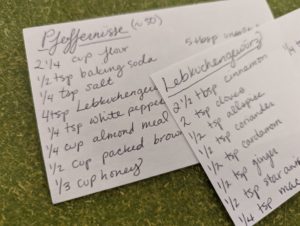 cookies) that brings back the memories of a winter trip with friends years ago. “One of the joys of food for me is that it can so easily evoke memories and sensations from good times with those I love, or on adventures in places I love. Pfeffernüsse will always remind me of the Christmas I spent in Berlin visiting friends. One bite and I’m suddenly coming in from the biting cold to have a small treat of the spiced cookie and a cup of hot tea after my daily ritual of wandering through the neighborhood Weihnachtsmarkt. The glazed version is common, but I also like them with a dusting of powdered sugar or just plain.” Keep scrolling for her full recipe!
cookies) that brings back the memories of a winter trip with friends years ago. “One of the joys of food for me is that it can so easily evoke memories and sensations from good times with those I love, or on adventures in places I love. Pfeffernüsse will always remind me of the Christmas I spent in Berlin visiting friends. One bite and I’m suddenly coming in from the biting cold to have a small treat of the spiced cookie and a cup of hot tea after my daily ritual of wandering through the neighborhood Weihnachtsmarkt. The glazed version is common, but I also like them with a dusting of powdered sugar or just plain.” Keep scrolling for her full recipe!
Barbara’s Okra, Cornbread, and Sweets
Barbara, a senior living in the Fillmore who picks up groceries at her neighborhood pantry, sees the holidays as an opportunity. “My favorite recipes for the holidays are things you don’t make on a regular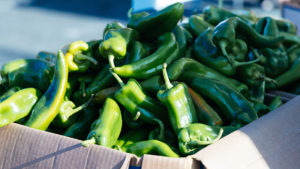 basis, traditional recipes that comes down from your family. My favorite recipe that was passed down to me is my mother’s okra.” At first thoughtfully pondering what else makes up her usual holiday table, Barbara began quickly listing other favorites: “I’m a dessert person, so I make lemon pies, coconut pineapple cake, peach cobblers and banana puddings. Oh, and cornbread dressing! Because there’s no recipe for that – it has the basics, the trinity: onion, pepper, celery. But it’s more of a feeling. So, the trick to that is to make a scratch cornbread.” We agree. Often, the best recipes aren’t written down or in a cookbook – they’re a feeling, or a memory.
basis, traditional recipes that comes down from your family. My favorite recipe that was passed down to me is my mother’s okra.” At first thoughtfully pondering what else makes up her usual holiday table, Barbara began quickly listing other favorites: “I’m a dessert person, so I make lemon pies, coconut pineapple cake, peach cobblers and banana puddings. Oh, and cornbread dressing! Because there’s no recipe for that – it has the basics, the trinity: onion, pepper, celery. But it’s more of a feeling. So, the trick to that is to make a scratch cornbread.” We agree. Often, the best recipes aren’t written down or in a cookbook – they’re a feeling, or a memory.
Steve’s Turkey Dinner
“I think holiday meals are always a way of coming together with family,” Steve told us at his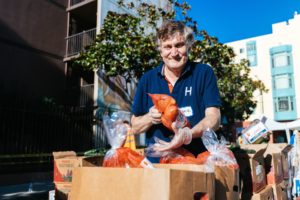 neighborhood pantry. He’s a military retiree and a volunteer at his local pantry, where he also picks up groceries for him and his wife. For his family, the holidays are about the joining of different traditions. “I have a traditional turkey dinner, where I usually go up to my sister’s house for Thanksgiving. And then I host a turkey dinner for my wife’s family. My wife’s Chinese, so we tend to do Chinese vegetables, mashed potatoes and cranberries [on the side].”
neighborhood pantry. He’s a military retiree and a volunteer at his local pantry, where he also picks up groceries for him and his wife. For his family, the holidays are about the joining of different traditions. “I have a traditional turkey dinner, where I usually go up to my sister’s house for Thanksgiving. And then I host a turkey dinner for my wife’s family. My wife’s Chinese, so we tend to do Chinese vegetables, mashed potatoes and cranberries [on the side].”
Kim’s Naw Mai Fan
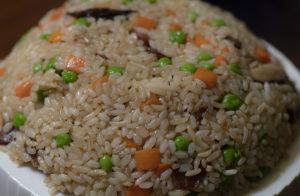 As Program Manager at the Food Bank, Kim is around good food quite a bit! But nothing quite compares to her family recipe for naw mai fan. “This is my mom’s recipe. She learned how to make this from my grandmother, an immigrant from the Toisan region of China in Guandong province. My grandmother came to San Francisco’s Chinatown right after World War II, where she raised my mother. We make naw mai fan every Thanksgiving and Christmas and it is my all-time favorite food.” Full recipe is included below, so please let us know if you give it a try!
As Program Manager at the Food Bank, Kim is around good food quite a bit! But nothing quite compares to her family recipe for naw mai fan. “This is my mom’s recipe. She learned how to make this from my grandmother, an immigrant from the Toisan region of China in Guandong province. My grandmother came to San Francisco’s Chinatown right after World War II, where she raised my mother. We make naw mai fan every Thanksgiving and Christmas and it is my all-time favorite food.” Full recipe is included below, so please let us know if you give it a try!
María’s Ponche con Piquete
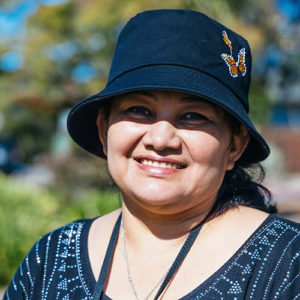 Sharing is caring! María is a mom, volunteer, and pantry participant in San Rafael. She told us that her family embraces potlucks during the holidays, but also for camping trips and other gatherings throughout the year. “Our tradition for Christmas is to get the whole family together, and everyone brings a little something. Someone brings the pozole, someone else the tamales, the champurrado, the ponche. We make ponche con piquete, like we call it back home – it’s made from fruit, and you add wine to your liking.”
Sharing is caring! María is a mom, volunteer, and pantry participant in San Rafael. She told us that her family embraces potlucks during the holidays, but also for camping trips and other gatherings throughout the year. “Our tradition for Christmas is to get the whole family together, and everyone brings a little something. Someone brings the pozole, someone else the tamales, the champurrado, the ponche. We make ponche con piquete, like we call it back home – it’s made from fruit, and you add wine to your liking.”
This is just a small sampling of the wide variety of food traditions in our community – a huge thank you to all who shared with us! To neighbors across San Francisco and Marin, we wish you a happy holiday season. We hope some of these recipes and stories inspire your next culinary adventure!
Detailed Recipes
Thank you to Katherine for sharing her Pfeffernüsse recipe. Here it is, in full:
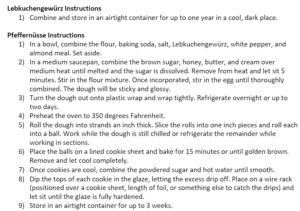
Thank you to Kim for sharing her family’s naw mai fan recipe. Here it is, in full:
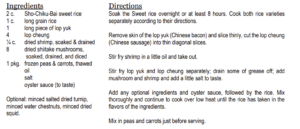


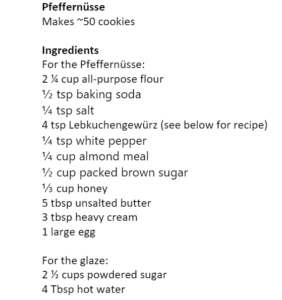
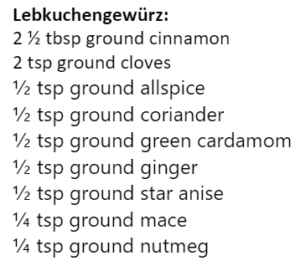

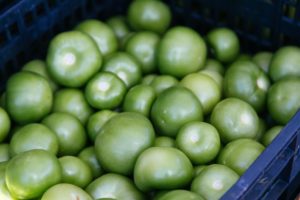 CROps is an effort to provide more culturally responsive foods and more choice for our Black and Latinx participants, By supplying culturally relevant items people like and know how to use in the kitchen, this pilot hopes to increase satisfaction with the food choices offered,
CROps is an effort to provide more culturally responsive foods and more choice for our Black and Latinx participants, By supplying culturally relevant items people like and know how to use in the kitchen, this pilot hopes to increase satisfaction with the food choices offered, 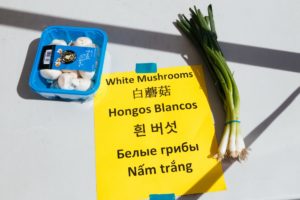
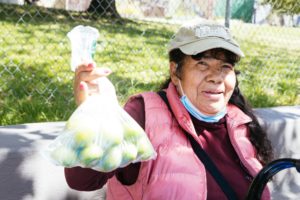 We also caught up with Maria at Cesar Chavez Pop-up Pantry, who is recovering from an operation on her stomach to remove a tumor: “I can’t eat out – my stomach is really fragile from the operation. Street food makes me sick. So, I need to cook at home, for my health.” New food and spice choices, like tomatillos and oregano, allow Maria to make comforting foods that aid her recovery.
We also caught up with Maria at Cesar Chavez Pop-up Pantry, who is recovering from an operation on her stomach to remove a tumor: “I can’t eat out – my stomach is really fragile from the operation. Street food makes me sick. So, I need to cook at home, for my health.” New food and spice choices, like tomatillos and oregano, allow Maria to make comforting foods that aid her recovery. 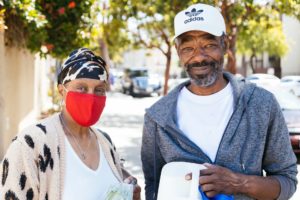
Share